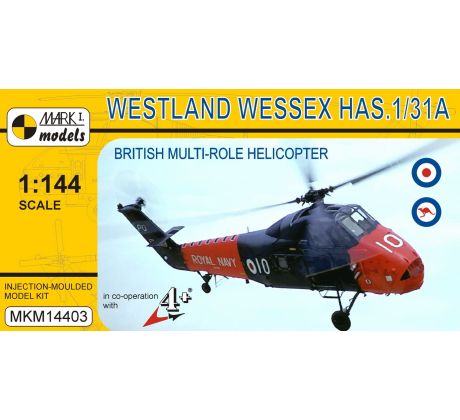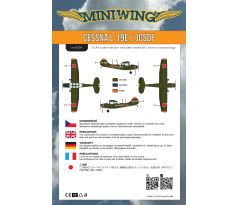Westland Wessex HAS.1/HAS.31A ‘British Multi-role Helicopter’

Westland Wessex HAS.1/HAS.31A ‘British Multi-role Helicopter’
This injection-moulded kit contains 38 parts and 6 clear parts (the cockpit canopy and the fuselage windows). A comprehensive instruction leaflet and a decal sheet are included.
Colour schemes included in the kit:
1) Wessex HAS.1, White XM840/300-R, No.815 NAS, Royal Navy, HMS Ark Royal, mid-1960s
2) Wessex HAS.1, White XM841/510-PO, No.771 NAS, Royal Navy, RNAS Portland (HMS Osprey), Dorset, 1973
3) Wessex HAS.1, White XS863, Aeroplane and Armament Experimental Establishment (A&AEE), Boscombe Down, Wiltshire, 1973
4) Wessex HAS.31A, White WA215/825, No.723 Sq. Royal Australian Navy, RANAS Nowra (HMAS Albatross), New South Wales, Australia, 1963
| Ref. No.: | MKM144003 |
| Availability: | IN STOCK |
Westland Wessex HAS.1/HAS.31A ‘British Multi-role Helicopter’
Description
A British licence development of the Sikorsky S-58, the Westland Wessex was a multi-role all-metal helicopter produced by Westland Aircraft Ltd. The Wessex HAS.1, powered by a Napier Gazelle turboshaft engine, first flew in June 1958 and the type began performing anti-submarine duties three years later, operated by the Royal Navy. A more powerful version, the HAS.3, with improved avionics and a radome on the rear fuselage, was introduced in 1967. In total, 140 HAS.1 helicopters were built, while 45 HAS.3 machines existed (all but three were conversions from HAS.1s).
In 1963 the Royal Australian Navy acquired a total of 27 Wessex helicopters designated the HAS.31A, of which 23 were later upgraded to Mk.31B standard, similar to that of HAS.3.
The RN Wessex HAS.1 and HAS.3s continued in service until 1979 and 1983, respectively, while the RAN’s HAS.31Bs served in ASW, SAR, utility and ambulance role until the end of 1989.
Products purchased together with this product
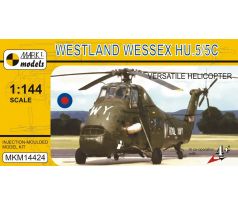
Westland Wessex HU.5/5C ‘Versatile Helicopter’
This injection-moulded kit contains 38 parts and 7 clear parts (the cockpit canopy and the fuselage windows). A comprehensive instruction leaflet and a decal sheet are included.
Colour schemes included in the kit:
1) Wessex HU.5, Black XS479/A-A, No.848 NAS, Royal Navy, HMS Albion, Borneo, Far East, 1965
2) Wessex HU.5, White XT475/WY, No.707 NAS, Royal Navy, RNAS Yeovilton, September 1975
3) Wessex HU.5, White XT474/20, No.771 NAS, RNAS Culdrose, 1988
4) Wessex HU.5C, Black XS485/Ace of Hearts, No.84 Squadron, UNFICYP (United Nations Peacekeeping Force in Cyprus) mission, Royal Air Force, RAF Akrotiri, Cyprus, 1993

Cessna L-19A / U.S. ARMY
8th Army, Korea 1952
Description:
14 Clear plastic parts
Canopy mask
Decals for one Aircraft
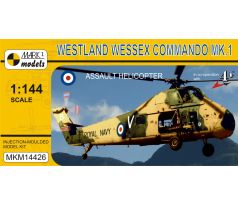
Westland Wessex Commando Mk.1 ‘Assault Helicopter’
This injection-moulded kit contains 34 parts and 6 clear parts (the cockpit canopy and the fuselage windows). A comprehensive instruction leaflet and a decal sheet are included.
Colour schemes included in the kit:
1) Wessex Commando Mk.1, Black XP138/M-B, No.845 NAS, Royal Navy, HMS Bulwark, September 1964
2) Wessex Commando Mk.1, Black XP107/D-A, No.845 NAS, Royal Navy, Borneo, January 1963
3) Wessex Commando Mk.1, Black XS154/V-B, No.845 NAS, Royal Navy, Borneo, May 1964
4) Wessex Commando Mk.1, Black XS151/R-B, No.845 NAS, Royal Navy, Borneo, 1964
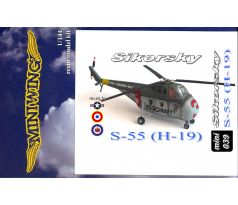
Sikorsky S-55 / H-19
American transport helicopter
Description:
20 resin parts
clear vac canopy
decals for three versions
Last seen productsCancel history

Westland Wessex HC.2/HAR.2 ‘RAF Workhorse’
This injection-moulded kit contains 38 parts and 7 clear parts (the cockpit canopy and the fuselage windows). A comprehensive instruction leaflet and a decal sheet are included.
Colour schemes included in the kit:
1) Wessex HC.2, Black XR505/WA, No.2 Squadron., No.2 Flying Training School, Royal Air Force, RAF Shawbury, spring 1995
2) Wessex HC.2, Black XR523/M, No.60 Squadron, Royal Air Force, RAF Benson, November 1995
3) Wessex HC.2, Black XS675/Ace of Spades, No.84 Squadron, UNFICYP (United Nations Peacekeeping Force in Cyprus) mission, RAF Akrotiri, Cyprus, February 1997
4) Wessex HAR.2, Black XV720, No.22 Squadron, SAR (Search & Rescue) Training Unit, Royal Air Force, SBAC Farnborough, September 1988 (RAF RESQUE) or RAF Valley, 1995 (RAF RESCUE)


